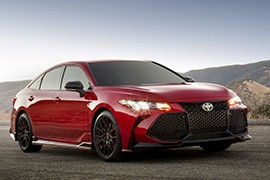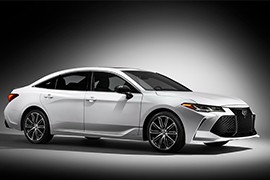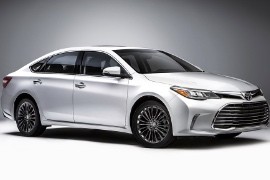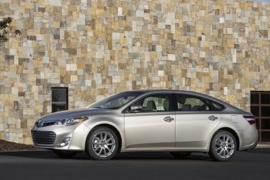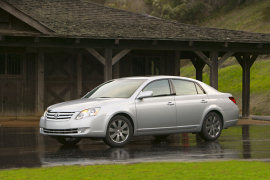TOYOTA Avalon Models/Series Timeline, Specifications & Photos
First production year: 2005
Engines: Hybrid, Gasoline
The latest generation of the Toyota Avalon TRD comes with a 3.5-liter v6 engine that develops 301 hp and 267 lb-ft of torque.
The TRD version includes all standard content from the Camry SE grade and Avalon XSE grade and is visually enhanced. The car has a more aerodynamic-looking body, including an eye-catching front splitter, side aero skirts, trunk lid spoiler, and rear diffuser, together with the available colors in Supersonic Red, Windchill Pearl, Celestial Silver Metallic and Midnight Black Metallic, all of which asserting a bold stance, matching the sporty dynamics of the vehicle.
Thicker underbody braces are maximizing the torsional rigidity and unique coil springs lower the vehicle by 0.6 inches for a reduced center of gravity compared with the regular Camry. Specially tuned shock absorbers and 19 x 8.5-inch matte black alloy wheels create a suspension package that improves body control, handling agility, and steering precision.
Toyota also equips the Avalon TRD with Black Sport SofTex-trimmed heated front seats, with Ultra-suede inserts and red accents. Additionally, the car comes with red-stitched TRD embroidered headrests, a leather-wrapped steering wheel with red stitching, red seatbelts and standard Toyota Safety Sense-P, a suite of advanced driver-assist technologies, among these Pre-Collision Braking, making it a reliable car.
Toyota introduced the fifth generation of the Avalon in January at the North American Auto Show in Detroit, and it was a shock for the entire audience since the car was no longer just another bland sedan on the market.
With more and more customers choosing SUVs, only a handful of automakers continued producing full-size sedans. Toyota still believed that the market needed such a vehicle, so it kept the Avalon nameplate on the market. Even though it shared the same TNGA platform with its notorious sibling Camry, it changed the Avalon's styling so much that it looked not just sporty but it also aggressive. In addition, depending on the engine, it could do the talk, not just walk the talk.
The car's front was dominated by the massive, broad grille. Depending on the trim level, it boasted either chromed details on the horizontal slats or a complete blacked-out element, complemented by other dark trims on the lower bumper, door pillars, and a lip spoiler on the back. Its full-LED headlights provided much better illumination over the road than the former halogen lamps used on the Avalon's previous generation. From its profile, the designer tried to create a cab-rearward design for the vehicle even though it was a front-wheel-drive platform. In the back, the automaker kept the wide aspect of the taillights complemented by a thin red line that crossed the trunk lid.
Inside, there were many options for customers for seating and comfort. As an option, they could get contoured seats with mild side bolstering that were good in keeping them safe while cornering.
Toyota installed a complex dashboard in front of the driver, with analog dials and a digital display inside the instrument cluster, while atop the center stack, the carmaker placed the 9" touchscreen for the infotainment unit that ran the Entune system. In the back, there was plenty of room for three passengers on the split-folding bench seat. Furthermore, the headroom was one of the most generous in its class.
But one of the most significant upgrades for the fifth generation of the Avalon happened to the platform. This generation came with the option of an adaptive suspension that muted the road bumps and potholes. In addition, the carmaker offered the option of 19" light-alloy wheels with fat tires that increased traction and improved the vehicle's dynamic. Under the hood, Toyota installed a choice of three powerplants. The base version featured a 2.5-liter naturally aspirated unit followed by a hybrid system, and the top-spec level that was powered by a 3.5-liter V6. The top and base models sent their power to the front wheels via an eight-speed automatic gearbox, while the hybrid used an eCVT transmission. The base version was also available with an all-wheel-drive system.
The Toyota Avalon received an update in 2015 for the 2016 model year. The refreshed Avalon received a wider, lower, front grille with narrow upper design, new turn signals, new LED taillights and some chrome on the rear bumper. For the Touring trim level, Toyota installed LED headlights with DRL. No longer is it stodgy and bland like the previous generation. It's styled much nicer inside and out.
Inside, there are new color stitches, woodgrain dash ornamentation and a 7” screen for the audio system, which has been upgraded to an Entune audio with navigation and an App Suite. The spacious interior remained the same, with enough legroom for the rear passengers.
For the Hybrid version, the Avalon has three trim levels, but it doesn't receive the sporty Touring version, which adds the 18” dark painted light-alloy-wheels.
Since the Avalon shares the same platform with the Lexus ES, it is considered more like e premium product than a mass-market one. Those who'll go for the Touring trim level will receive the sport shock-absorbers, for better handling.
Under the hood, there are two engine choices. The most common is the smooth 286 hp, 3.5-liter V6. It is mated to a 6-speed automatic transmission. The other choice is the hybrid version, which is a good choice for long roads. Its total power output is 200 hp, which doesn't look too many for a 1.630 kg (3594 lbs) car, but it can get from 0 to 60 mph (97 kph) in 7.4 seconds.
While the Avalon looked like it was designed to win an AARP contest, it managed to offer more than enough for the U.S. market than some of the Big-Three carmakers.
Toyota took the decision to build a car comfortable enough for those who are not in a hurry anymore but designed to be appealing for the middle-aged people. It was an interesting mix of old and new built on the reliability reputation of the Camry.
The fourth generation of the Avalon was introduced at the New York Auto Show in 2012 as a 2013 model-year. It sported an aggressive front fascia, with slim headlights and a vast grille on the bumper's lower side. The upper grille was almost unnoticeable.
Inside, the Avalon dropped the column-shifter from the previous generation and installed it on the center console, above the buttons for the front seat heaters. Its generous interior space was suitable for everyone, either tall or short, both in the front and back. There were a set of analog dials on the instrument cluster plus a TFT display in the middle for the on-board computer. The infotainment system took a big chunk from the center stack and featured large knobs, OK to use with gloves in the winter.
The Avalon didn't have a problem with the power output, and that featured stayed for the 2013 model. Toyota installed a choice of two engines in the front and mated them with a 6-speed manual gearbox.
Toyota launched the third generation of the U.S.-built Avalon in 2005 and shared its main underpinnings with the better-known Camry.
Built on the same K-Platform as its Camry sister, the Avalon tried to satisfy those who asked for a more potent vehicle. While a four-banger still powered the standard Camry, the Avalon featured V-6s only. It was no longer the preferred choice of AARP members.
While it kept a classic overall look, the Avalon had a dynamic look. Its HID headlights with their swept-back design gave the car a fresh image. The Avalon featured a body-colored or a chrome-plated grille above the aerodynamic-profiled bumper, depending on the trim level. A narrow, trapezoidal-shaped grille was installed on the apron, between the side-scoops that hosted the fog lights. The carmaker installed turn signals in the door mirrors. In the rear, the taillights sported a Lexus-like shape and two exhausts under the bumper.
Inside, the Avalon was more luxurious than its Camry sibling. A wide instrument cluster covered both the dials and the navigation screen placed above the center stack. To maintain a clean look for the dash, Toyota placed covers on most of the features, apart from the climate control buttons. All the storage areas from the consoles and the radio featured spring-loaded covers. An unusual system was for the tilt and reach controls of the steering wheel, with two separate levers. In the back, the Avalon was roomy, even for three people.
The Avalon was a big car with a punchy V-6 engine under the hood. Toyota paired it with a six-speed automatic gearbox. But it wasn't a sporty sedan; it was a more luxurious and faster Camry.
